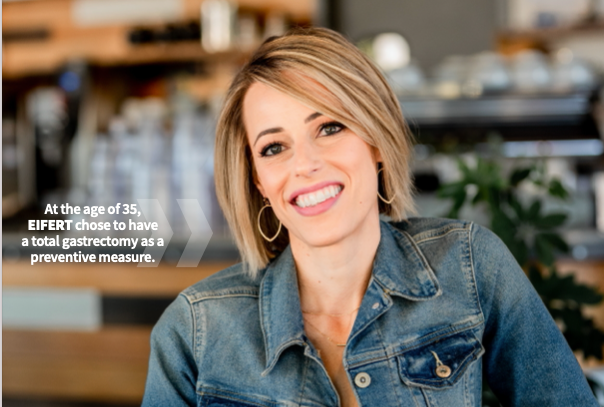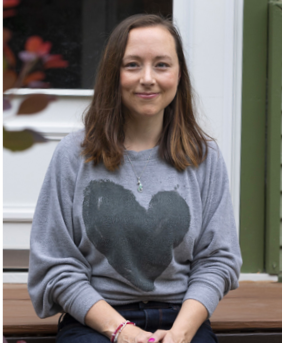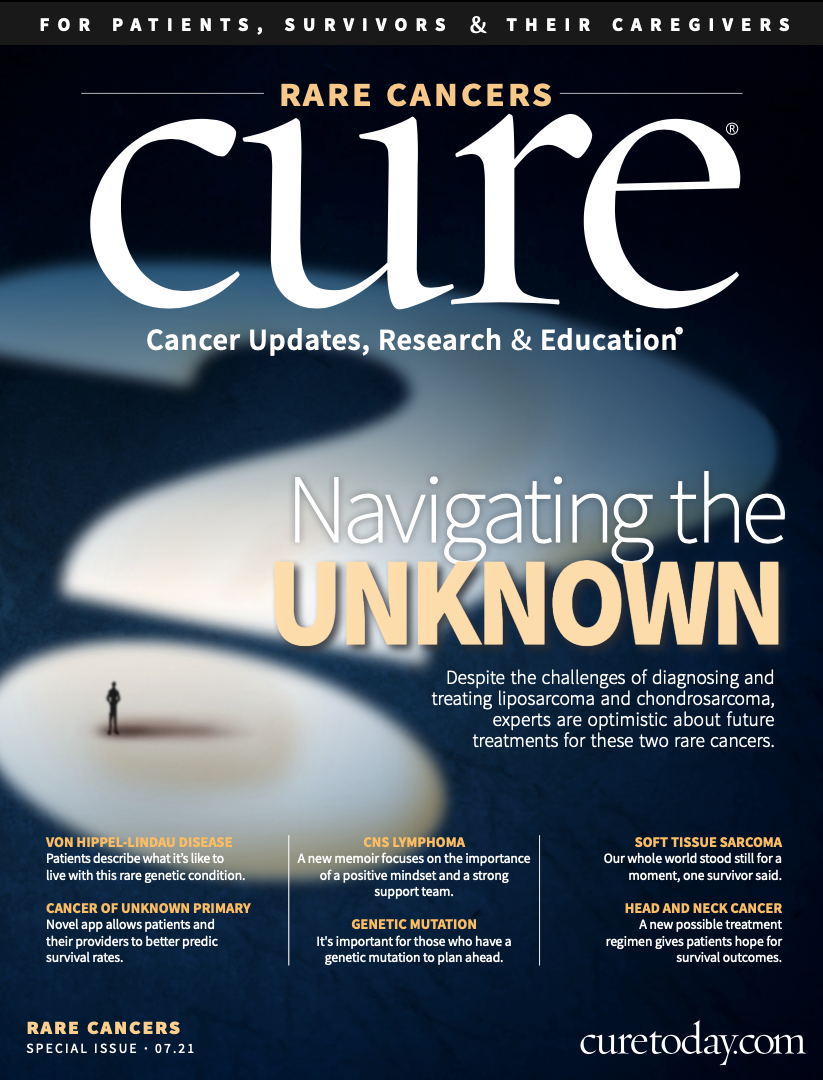Publication
Article
CURE
Looking Forward: Patients With Genetic Mutations Are Empowered to Make Plans
Author(s):
Knowing they’ve inherited a genetic mutation for stomach or breast cancer gives patients the power to plan ahead.
PHOTO BY KINSEY WHIDBY

When Karissa Eifert’s mother died in 2015 of hereditary diffuse gastric cancer (HDGC) caused by an inherited (also termed “germline”) mutation in the CDH1 gene, Eifert’s gynecologist proactively suggested she get genetic testing. Because of Eifert’s family history of breast cancer and her mother’s diagnosis, the doctor opted for a full panel of genetic screening.
A few weeks after, Eifert was told she had a mutation in the CDH1 gene. She was just 34 years old. Each year, about 27,000 people in the United States receive a diagnosis of stomach cancer. A very small percentage — 1% to 3% — have HDGC. The most common cause of the disease is the presence of a germline hereditary mutation in the CDH1 gene, which leads to an increased risk of diffuse stomach cancer and lobular breast cancer.
“About 20% to 40% of people who appear to have HDGC have an inherited mutation in the CDH1 gene,” says Dr. Jeremy Davis, a surgical oncologist at the National Cancer Institute (NCI) and lead investigator of the NCI’s Research Study for Hereditary Stomach Cancer.
The CDH1 gene directs development of a protein called epithelial cadherin, or E-cadherin. Found on cells that line the stomach and other organs, E-cadherin causes neighboring cells to stick to each other and form tissues. It can also function as a receptor involved in growth control. When the CDH1 gene is mutated, it causes abnormal, nonfunctional E-cadherin proteins that allow cells to grow and divide. It also increases the chances of cancer cells proliferating into the stomach wall and spreading throughout the organ.
More than 120 inherited types of CDH1 mutations are linked with HDGC.
Carriers of the CDH1 mutation have an elevated risk of developing either HDGC or, in women, lobular breast cancer, usually with onset before the age of 40. But not all patients with HDGC carry CDH1 gene mutations.
“The risk of getting gastric cancer (if you have a CDH1 mutation) is not 100%,” adds Davis. “But statistically, we think that your risk is much, much higher than the average population.” The latest evidence finds that these individuals have a 30% to 50% risk of developing HDGC by age 80. For women, the risk of lobular breast cancer is approximately 40% to 55% by age 80.
Genetic testing and counseling are two preliminary steps when a physician sees a patient with early-onset stomach cancer, lobular breast cancer or a family history of stomach cancer. For these patients, testing for the CDH1 mutation is often the first genetic test.
“We might recommend the panel if we are not totally sure what we are looking for, but we suspect a hereditary gene syndrome is involved,” Davis explains. “That is especially true if the CDH1 test comes back negative.”
Eifert’s family history of cancer concerned her, “but I had no clue I had (a mutation in) the CDH1 gene,” she says. “I consider having that information to be a gift that my mother didn’t have.”
Kate King-Scribbins, who received a diagnosis of lobular breast cancer at age 32, also went through genetic testing before discovering that she was positive for a CDH1 mutation. While lobular breast cancer is the second most common type of breast cancer, it is 30 times less common to derive it from the CDH1 mutation compared with more common gene mutations like BRCA2.
“My mother had breast cancer, but she did not have CDH1,” she says, explaining that the CDH1 mutation came from her father’s side, with several family members having early breast cancer. “They were going to test only for BRCA1/2, but I wanted to push for all of the genes — given my family history — so I got the whole gene panel. That’s when I learned I had the CDH1 mutation.”
TREATMENT OF HDGC
“For patients who have a family history of stomach cancer and the CDH1 (mutation), the recommendation is to have a total gastrectomy or removal of the stomach,” Davis explains.
The decision to act on the discovery of a CDH1 mutation is influenced by many factors. If cancer is already present, the treatment choices are fairly straightforward: surgery usually followed by appropriate chemotherapy. When the CDH1 mutation is discovered but the patient has not developed any cancer, choices are more varied — especially if they have a family history of HDGC. They can either elect for gastrectomy (total removal of the stomach) or a period of intensive surveillance with endoscopy every 12 months.
Eleven months after Eifert’s diagnosis, she opted for a total gastrectomy at the NCI at the age of 35. “My endoscopies were actually clear, but I wanted to move forward with the total gastrectomy,” she explains. “I wanted to beat (HDGC) to the punch.” The first year after surgery was hard; during that time, she experienced intense bile reflux and rapid weight loss. “I also lost the desire to eat since I was frequently nauseous,” she says.
Eifert is now 18 months post-surgery and has been working regularly with a dietitian. “I feel like my old self again,” she says, noting that she lives a fairly active lifestyle of hiking in Rapid City, South Dakota. “I have most of my energy back and eat most things. Eating is less of a chore, which makes a huge difference for me mentally. I now enjoy and crave food again.”
After her surgery, however, Eifert received a diagnosis of stage 1A gastric cancer after a pathology on her stomach showed small areas of precancerous cells. Of note, she has not needed further treatment.
After undergoing a mastectomy, chemotherapy and radiation treatment for lobular breast cancer and learning she had the CDH1 mutation, King- Scribbins joined Davis’ HDGC clinical study at the NCI, which is focused on learning the best ways to screen for and treat the disease. Like Eifert, she opted for a gastrectomy. “The whole process has definitely taken its toll. I lost both breasts, my stomach and ultimately my gall bladder,” King-Scribbins says about her three years of surgeries and recovery. “I wasn’t about to go through all that treatment for breast cancer and then let stomach cancer take me out.”
Patients who do not wish to immediately move to surgery — either for a total gastrectomy to prevent diffuse stomach cancer or mastectomy to prevent lobular breast cancer — instead undergo intensive surveillance.
“The decision when to have a gastrectomy when you may be 25 years old is a heavy burden,” says Dr. Fabian Johnston, division chief of gastrointestinal oncology at Johns Hopkins Medicine in Baltimore. He adds that he sees many patients who choose surveillance until they are in their early 30s or the risk of cancer increases.
During the procedure, a tube is inserted into the stomach through the mouth. Samples of stomach tissue are collected and analyzed in a lab for the presence of abnormal cancerous signet-ring-shaped cells. In HDGC, these cells grow and often cluster together in the diffuse pattern associated with the disease.
The decision between surgery and monitoring is further complicated because individuals with the CDH1 mutation may undergo prophylactic gastrectomy: the removal of the stomach prior to known evidence of cancer. “When we do random biopsies, we will find precancerous cells about 40% of the time if we just happen to hit the right spot,” Davis adds, noting that he usually finds cancer cells in 95% of patients who have had prophylactic gastrectomy.
Because HDGC is not symptomatic until it is relatively advanced, endoscopy can be useful for catching some cancers at an early stage. “Anyone with the CDH1 mutation should get the endoscopy when they are diagnosed and every year after that for monitoring,” explains Dr. Daniel Sussman, professor of clinical medicine in the gastroenterology division at the University of Miami Health System. “The drawback of using endoscopy for surveillance is that we biopsy only certain areas of the stomach and can miss these early cancer cells.”
“That tells me that endoscopy is not that great if we only find them 40% of the time as opposed to 95%.”
For this reason, patients with HDGC or those with the CDH1 mutation are advised to seek care at a medical center experienced in monitoring, diagnosing and treating HDGC. This includes seeing an advanced endoscopist trained to monitor HDGC with specialized endoscopy scopes created to visualize hard-to-see cancerous cells.
For women with the CDH1 mutation or with stomach cancer diagnosed when they were young, breast cancer screening is recommended as early as age 30. “We recommend starting with breast MRI since lobular breast cancers are more insidious than diffuse breast cancer, and they are harder to identify on mammography,” Johnston explains. Since her CDH1 diagnosis and gastrectomy, Eifert has been alternating between mammography and breast MRI screening tests every six months. “At this point, I’m not certain what steps I may take in the future,” she says, referring to prophylactic mastectomy. “I’m in the early stages of learning and formulating a plan.”
REMAINING QUESTIONS
Since her diagnosis, KING- SCRIBBINS has dedicated herself to helping others who also received a diagnosis of gene mutation
at a young age.
PHOTO BY LAURIE SCHNEIDER

As research into the genetics of the disease sheds more light on this rare cancer, some important questions remain. “We still don’t know who should definitely choose a prophylactic gastrectomy,” Davis explains. “Although the risk between CDH1 and HDGC is well established, beyond that, we cannot yet provide individual risk assessments.”
Because some patients with the gene mutation never develop HDGC, it is also important to find out why. “Since we know we almost always find early signs of HDGC after gastrectomy, why do some of them appear to be relatively indolent and others are very aggressive?” asks Sussman. “We need to understand that so we can, hopefully, intervene and perhaps find ways to prevent advanced cancer.”
Another relative unknown is what other genetic mutations may contribute to HDGC. Although CDH1 has the longest and strongest association with the cancer, other genetic mutations have been linked to it over the past several years.
ENJOYING LIFE, HELPING OTHERS
Today, Eifert is back to work as an interior designer and counsels others with similar diagnoses through her blog, Reverie Rising. Having battled insurance issues and the lack of resources in her area, she advises others to be informed, follow their instincts, advocate for themselves, push for what they need and look for answers in online Instagram and Facebook communities and from specialty medical centers. “Having the knowledge, it gives you the power to determine how you want to handle your options. So many people don’t have the opportunity to proactively influence their outcomes, but you can with a CDH1 diagnosis,” she says.
Similarly, King-Scribbins — who talks more about her journey on her blog, “My Pink Genes,” where she also provides helpful resources for others with the disease — is committed to helping others. “I don’t want (others) to feel as alone as I did going through this at such a young age,” she says.
For more news on cancer updates, research and education, don’t forget to subscribe to CURE®’s newsletters here.





